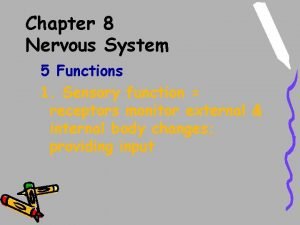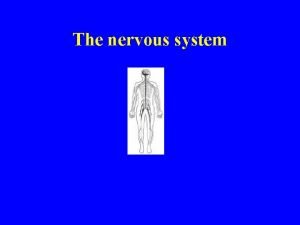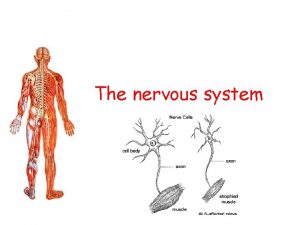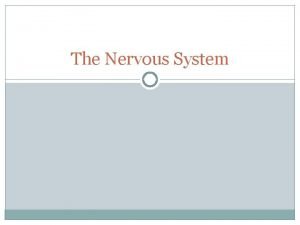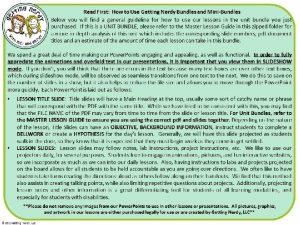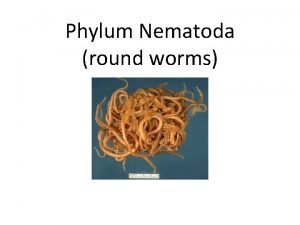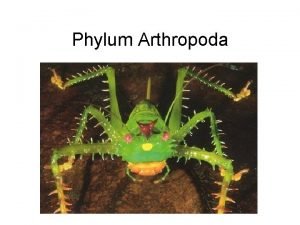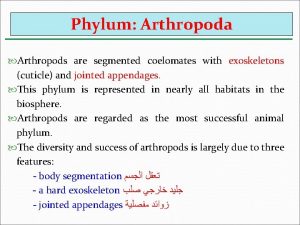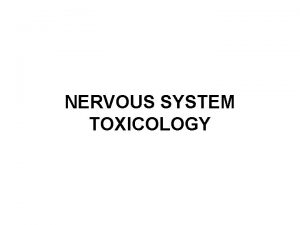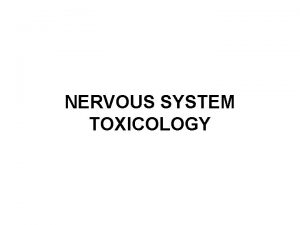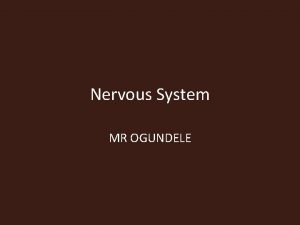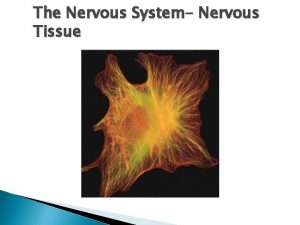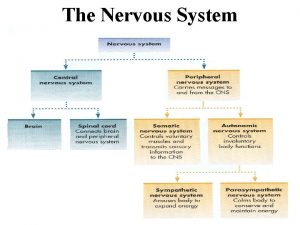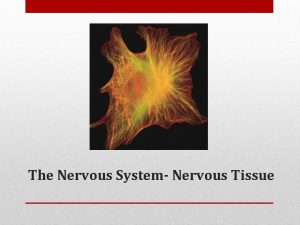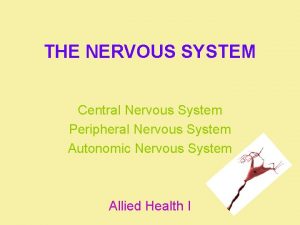The Nervous System The nervous system u Functions





























- Slides: 29

The Nervous System

The nervous system u Functions 1. Receive information from internal/external environment or other nerve cells 2. Integrate the information and produce an appropriate output signal 3. Conduct the signal 4. Transmit the signal to other nerve cells, glands, or muscles

The nervous system u Structural regions of typical vertebrate neurons 1. Dendrites respond to external signals through the binding of receptor sites 2. Cell body serves as the integration center and carries out basic metabolism 3. Axon conducts signals long distances 4. Synaptic terminal releases neurotransmitters to communicate with other cells

Synaptic terminals: Bring signals from other neurons. Action potential starts here. Myelin: Insulates the axon and speeds conduction. Exposed areas of axon. Synaptic terminals: Transmit signals to other neurons. Dendrites: Receive signals from other neurons. Cell body: Integrates signals; coordinates metabolic activities. Arrows indicate direction of travel of action potential. Dendrites of other neurons receive signals.

The nervous system u Mechanisms of neural activity • 1. Electrical signals and membrane potentials • a. Resting potential • b. Action potential

action potential threshold resting potential



The nervous system u Mechanisms of neural activity 2. Communication between neurons • a. Synapses • • 1) Presynaptic neurons 2) Postsynaptic neurons • b. Neurotransmitters and ion gradients • c. Excitatory and inhibitory potentials

presynaptic neuron postsynaptic neuron 1 An action potential is initiated. synaptic vesicle synaptic terminal 3 Synaptic vesicles release neurotransmitter 4 Receptor binds neurotransmitter and opens ion channel. 2 The action potential reaches the synaptic terminal of the presynaptic neuron. gap ion channel closed dendrite of postsynaptic neuron plasma membrane of postsynaptic neuron


The nervous system Operation of the nervous system 1. Four basic requirements a. Determine the type of stimulus 1) Wiring patterns in the brain 2) Nervous system monitors which neurons are firing

The nervous system Operation of the nervous system b. Signal the intensity of the stimulus 1) All action potentials are of the same magnitude 2) Frequency of action potentials signals intensity 3) Number of firing neurons signals intensity

(a) Gentle touch gentle touch; 1 fires slowly, 2 is silent (b) Moderate pressure (c) Strong pressure moderate pressure; 1 fires more rapidly, 2 is silent strong pressure: both 1 and 2 fire

The nervous system Operation of the nervous system c. Integrate information from many sources 1) Convergence of many neuron signals to fewer neurons d. Initiate and direct the response 1) Divergence—signals sent from a few decisionmaking cells to many neurons controlling the responses

white matter (contains myelinated axons) central canal gray matter (contains cell bodies of motor and association neurons) dorsal root (contains axons of sensory neurons) dorsal root ganglion (contains cell bodies of sensory neurons) peripheral nerve ventral root (contains axons of motor neurons)

The nervous system Operation of the nervous system Neural control of behavior a. Pathway contains four components 1) Sensory neurons—respond to a stimulus 2) Association neurons—activate motor neurons 3) Motor neurons—activate muscles or glands 4) Effectors—usually muscles or glands

The nervous system 2. Neural control of behavior b. Simple behavior – the reflex c. Complex behaviors

Step 1: a painful stimulus activates a pain receptor Step 2: signal transmitted by a sensory neuron receptor stimulus Step 5: effector muscle causes withdrawal response dorsal root effector association sensation neuron relayed to the brain REFLEX ARC ventral root Step 4: activation of a motor neuron stimulates the appropriate muscle Step 3: signal transmitted within the spinal cord

The human nervous system u A. Peripheral nervous system • Somatic nervous system—controls voluntary movement • Autonomic nervous system—controls involuntary responses • a. Sympathetic division—energetic and stressful activities • b. Parasympathetic division—leisure and maintenance activities


The human nervous system u B. Central nervous system (CNS) • 1. Brain • a. Functions • 1) Integration: senses, processes, and directs responses

The human nervous system Brain Structure 1) Hindbrain a) Contains the medulla, pons, and cerebellum b) Controls automatic functions of breathing, heart rate, blood pressure, swallowing, sleeping, and coordination of movements 2) Midbrain a) Contains the reticular formation b) Center for relay control and filtering sensory messages

FOREBRAIN (within dashed blue line) hypothalamus pituitary gland cerebral cortex meninges skull corpus callosum thalamus MIDBRAIN cerebellum pons medulla spinal cord HINDBRAIN

The human nervous system Brain Structure 3) Forebrain a) Thalamus shuttles sensory information to the cerebrum and limbic system • b) The limbic system controls instincts and emotions i) The limbic system includes the hypothalamus, amygdala, and hippocampus c) The cerebral cortex produces thoughts and perceptions i) Damage to the cerebral cortex

cerebral cortex thalamus hypothalamus amygdala hippocampus

Primary Motor Area Primary Sensory Area higher intellectual functions leg trunk arm hand face Sensory Association Area Visual Association Area tongue Speech Motor Area Primary Auditory Area memory language comprehension and formation Primary Visual Area

The human nervous system u B. Central nervous system (CNS) (cont. ) • 2. Spinal cord • • • a. A cable of axons protected by the backbone b. Conducts signals to the brain c. Spinal cord injuries

The human nervous system u C. The brain and the mind • • • u 1. Brain and mind research 2. Left-brain functions 3. Right-brain functions D. Memory and learning • • 1. 2. 3. 4. Working memory Long-term memory Learning involves the hippocampus Neither is well understood
 Which neuron is rare
Which neuron is rare Nervous
Nervous Processes of neuron
Processes of neuron Primary functions of the nervous system
Primary functions of the nervous system 5 functions of the nervous system
5 functions of the nervous system Nervous system and digestive system
Nervous system and digestive system Endocrine system vs nervous system
Endocrine system vs nervous system Endocrine vs nervous system venn diagram
Endocrine vs nervous system venn diagram Adh function
Adh function Absolute value of x as a piecewise function
Absolute value of x as a piecewise function I can evaluate functions
I can evaluate functions Evaluating functions and operations on functions
Evaluating functions and operations on functions Chemical messengers of the nervous system
Chemical messengers of the nervous system Platyhelminthes examples
Platyhelminthes examples The nervous system is made up of
The nervous system is made up of Nervous system learning objectives
Nervous system learning objectives Componentes componentes
Componentes componentes What is stimuli in nervous system
What is stimuli in nervous system Spinal cord structure
Spinal cord structure Parasympathetic and sympathetic
Parasympathetic and sympathetic Autonomic nervous system def
Autonomic nervous system def Plexuses
Plexuses Sns somatic nervous system
Sns somatic nervous system The nervous system brain scienstructable
The nervous system brain scienstructable Autonomic nervous system skeletal muscle
Autonomic nervous system skeletal muscle Nematoda
Nematoda Tagma
Tagma Chelicerates antennae
Chelicerates antennae Are arthropods coelomates
Are arthropods coelomates Division of central nervous system
Division of central nervous system




